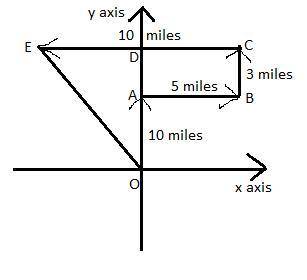
Physics, 19.09.2020 01:01 alupton4887
You are going for a drive, but a detour takes you out of the way of your destination. You
drive north for 10 miles, turn right and drive east for 5 miles, turn to the north and drive for 3
miles, drive west for 10 miles, and arrive at your destination.
a) How far from where you started did you end up?
b) If you wanted to travel directly to your destination without following the streets (“as the
crow flies”), what angle would you take? What direction would a compass read?
c) Now try adding the vectors in a different order. For example, start with the 5 miles east,
then 3 miles north, etc., as long as you add all four vectors. Compare the result to the sum
in part a). Draw the vectors in the order you used.

Answers: 3


Another question on Physics

Physics, 21.06.2019 17:30
The position of a dragonfly that is flying parallel to the ground is given as a function of time by r⃗ =[2.90m+(0.0900m/s2)t2]i^− (0.0150m/s3)t3j^. a: at what value of t does the velocity vector of the insect make an angle of 34.0 degree clockwise from the x-axis? b: at the time calculated in part (a), what is the magnitude of the acceleration vector of the insect? c : at the time calculated in part (a), what is the direction of the acceleration vector of the insect?
Answers: 1

Physics, 21.06.2019 18:00
Stars x and y are both bluish main sequence stars. star x has a higher absolute brightness than star y. how do the two stars compare? explain
Answers: 1


Physics, 22.06.2019 15:30
To understand the electric potential and electric field of a point charge in three dimensions consider a positive point charge q, located at the origin of three-dimensional space. throughout this problem, use k in place of 14? ? 0. part adue to symmetry, the electric field of a point charge at the origin must point from the origin.answer in one word.part bfind e(r), the magnitude of the electric field at distance r from the point charge q.express your answer in terms of r, k, and q. part cfind v(r), the electric potential at distance rfrom the point charge q.express your answer in terms of r, k, and q part dwhich of the following is the correct relationship between the magnitude of a radial electric field and its associated electric potential ? more than one answer may be correct for the particular case of a point charge at the origin, but you should choose the correct general relationship. a)e(r)=dv(r)drb)e(r)=v(r)rc)e(r)=? dv(r)drd)e(r)=? v(r)r
Answers: 2
You know the right answer?
You are going for a drive, but a detour takes you out of the way of your destination. You
drive nor...
Questions

Mathematics, 02.05.2021 22:30

Mathematics, 02.05.2021 22:30

Mathematics, 02.05.2021 22:30

Mathematics, 02.05.2021 22:30

History, 02.05.2021 22:30


Mathematics, 02.05.2021 22:40




Mathematics, 02.05.2021 22:40

Mathematics, 02.05.2021 22:40


Mathematics, 02.05.2021 22:40

Biology, 02.05.2021 22:40

English, 02.05.2021 22:40



Mathematics, 02.05.2021 22:40











